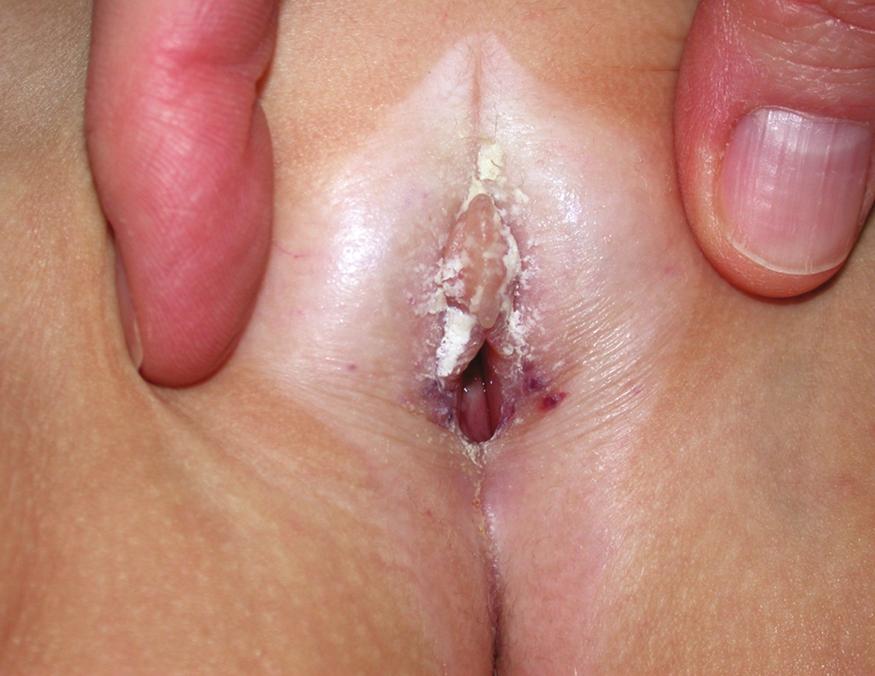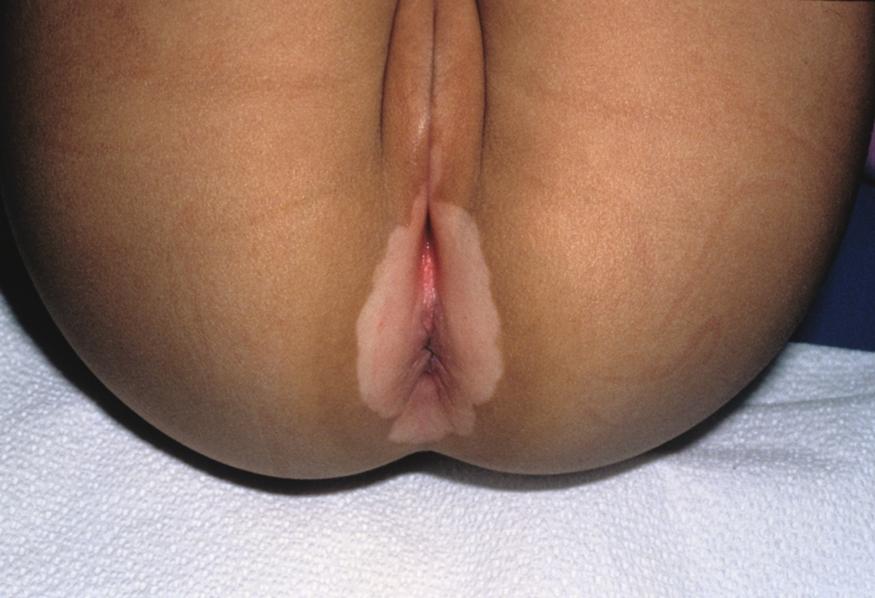Physical Address
304 North Cardinal St.
Dorchester Center, MA 02124
Lichen sclerosus (LS) ( Fig. 60.1 ) is an inflammatory condition that primarily affects the epidermis and the superficial dermis. The disease process results in thinned or atrophic white papules and plaques of the skin. It is estimated that LS affects 1:60 women. LS primarily affects the anogenital region, but it can also present on the trunk or extremities. LS of the vulva most commonly affects postmenopausal women, but it can also develop in 7% to 15% of prepubertal females.

Pérez-López FR, Vieira-Baptista P. Lichen sclerosus in women: a review. Climacteric . 2017;20(4):339–347.
The characteristic findings associated with LS include white, thinned, crinkled skin (it is frequently described as “cigarette paper” atrophy). Often, there is absorption of the labia minora, fusion of the labia minora to the labia majora, and fusion of the clitoral hood. One also may find vular fissures. The majority of the vagina is usually unaffected; however, a patient may have involvement of the vaginal introitus, leading to stenosis. LS can also simultaneously involve the perianal area, which then forms a “figure-of-eight” pattern.
Zendell K, Edwards L. Lichen sclerosus with vaginal involvement: report of 2 cases and review of the literature. JAMA Dermatol . 2013;149(10):1199–1202.
The most common symptom associated with LS is pruritus. Patients may also report burning, bleeding, and tearing of the vulva or vaginal introitus. If stenosis of the vaginal introitus is present, dyspareunia is often reported.
Yes. Biopsy of the affected site can aid in differentiating LS from other disorders, such as vitiligo ( Fig. 60.2 ) and lichen planus. Hyperkeratotic, ulcerated, or nodular lesions should be sampled to rule out vulvar intraepithelial neoplasia (VIN) or squamous cell carcinoma (SCC) of the vulva. The risk of LS becoming malignant is 4% to 6%.

Yes. Research supports that the etiology of LS has a strong autoinflammatory component. Immunoglobulin G (IgG) antibodies targeting the extracellular matrix 1 (ECM-1) protein have been found in 74% of women with LS, as opposed to 7% in controls. Concomitant diseases that may be present with LS include Hashimoto’s thyroiditis (12% to 30%), alopecia areata (9%), or vitiligo (6%). Other autoimmune diseases may also be present. Additionally, secondary concomitant infection with yeast or bacteria is common in LS and should be treated accordingly.
Pérez-López FR, Vieira-Baptista P. Lichen sclerosus in women: a review. Climacteric . 2017;20(4):339–347.
Fistarol SK, Itin PH. Diagnosis and treatment of lichen sclerosus: an update. Am J Clin Dermatol. 2013;14(1):27–47.
The most widely accepted first-line treatment is use of a high-potency topical corticosteroid, most commonly clobetasol propionate 0.05% ointment. Other therapies used for LS include intralesional corticosteroids (recalcitrant), methotrexate, retinoids, chloroquine, tacrolimus/pimecrolimus, cyclosporine, and photodynamic therapy with topical 5-aminolevulinic acid. LS in children often will resolve at the time of puberty.
Lee A, Fischer G. Diagnosis and treatment of vulvar lichen sclerosus: an update for dermatologists. Am J Clin Dermatol . 2018;19(5):695–706.
Lichen planus
Vitiligo
VIN
Sexual abuse (children)
Inverse psoriasis
Lichen planus is an autoimmune inflammatory disorder. The exact pathogenesis is not completely understood, but it is thought to be a T-cell–mediated disorder that results from damage to the epidermal basement membrane secondary to antibodies directed against components of the basal keratinocytes.
Yes. Variants that affect the vulva include erosive lichen planus, papulosquamous lichen planus, and hypertrophic lichen planus. The most common variant found in the vulvar vestibule is erosive lichen planus. This variant is characterized by erosions of the vulvar mucosa, the vaginal introitus, and, often, the vagina. One may also see alterations of the vulvar anatomy similar to that found with lichen sclerosus. Unlike LS, lichen planus more commonly affects the vagina leading to stenosis, synechiae, and scarring. Oral-vulval-vaginal lichen planus may also be seen. One study reported that of the women with oral LP, 75% also had genital involvement.
Andreassi L, Bilenchi R. Non-infectious inflammatory genital lesions. Clin Dermatol. 2014;32(2):307–314.
ACOG Practice Bulletin No. 93. diagnosis and management of vulvar skin disorders. Obstet Gynecol. 2008;93:1243–1253.
Patients most commonly present with complaints of vulvovaginal burning, pruritus, postcoital bleeding, and dyspareunia. Up to 70% of patients also have vaginal lesions. There may be an associated purulent vaginal discharge, and chronic erosions of the vaginal epithelium can lead to the development of extensive adhesions leading to vaginal narrowing and obliteration.
Lewis FM. Vulval lichen planus. Br J Dermatol. 1998;138(4):569–575.
Become a Clinical Tree membership for Full access and enjoy Unlimited articles
If you are a member. Log in here